高圧鋳造とは? 量産ダイカストの製品原価と価格
高圧ダイカスト (HPDC) 連続生産または大量生産のための鋳造プロセスです. 通常、これには低融点の鋳造合金が使用されます。.
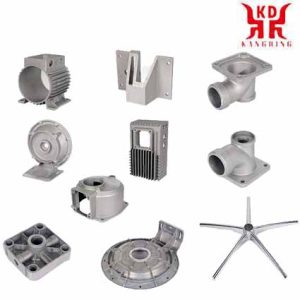
China Die Casting
ダイカストでは, 液体溶融物をダイカスト金型に押し込みます。 (鋳造金型, 空洞) 約約の高圧下で. 10 に 200 MPa および最大 2000 の非常に高い金型充填速度で 12 メートル / s, その後固まる場所. ダイカストプロセスの特別な点は、永久的な金型を使用することです。, つまり. H. モデルなしで. 結果として, 金型は一連の同一のコンポーネントに対して 1 回だけ製造されます, ただし、生産にかなりの労力がかかります. このようにして, 高出力が達成されます, 特に、鋳造容器と鋳造ピストンが常に溶融状態にあるホットチャンバーダイカストマシンでは、. In the case of alloys with a higher melting point, the cold chamber pressure casting process is used; the casting set is located outside of the metallic melt.
How does the high pressure casting process work?
高圧鋳造工程において, 溶融金属または金属合金を高速かつ高圧で金型に注入します。.
横型高圧ダイカストマシンは金型が完全に閉じていることを保証します. それらは適用できるクランプ力の量に応じて分類されており、その範囲は次のとおりです。 550 に 5700 トン.
使用する金属にもよりますが、, 金型に充填する射出ユニットは、ホット チャンバーまたはコールド チャンバーのいずれかになります。. ホットチャンバー内ダイカスト, 金属はダイカストマシン自体の中に保持されます, その後、チャンバー内に引き込まれ、射出ピストンの作用により金型に導入されます。. These parts of the machine are always in contact with the molten metal.
コールドルームプロセスで, 金属は最初に別の炉で溶解され、保持炉に移されます。; 次に、充填チャンバーに注入され、金型に射出されます。. offers a wide range of cold chamber high pressure casting machines.
Die casting competes with injection molding with plastics. Metallic materials have advantages in individual cases that secure the market for die-cast articles.
The most commonly used materials are
アルミニウム (die-cast aluminum)
Zinc (die-cast zinc)
Magnesium (magnesium die-cast)
Silicon tombac
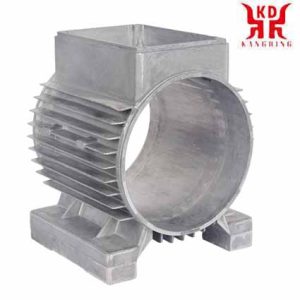 Motor housing die casting |
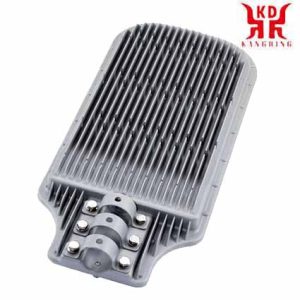 Street lamp die casting |
 Distribution box die casting |
Die-cast parts properties
Die-cast parts have smooth, clean surfaces and edges. 加えて, this method allows wall thicknesses to be thinner than other methods. With zinc, 例えば, the parts can have a wall thickness of 1 mm and with aluminum of 1.4 んん, in exceptional cases even less than 1 んん.
The achievable tolerances are ± 0.05 to ± 0.15 んん, so that one speaks of an exact or finished casting. For large cast parts, しかし, slightly larger tolerances are required.
It is possible to use parts made of other materials, のような. B. sockets, threaded bolts or pins to be poured in. Internal threads are produced directly with rotatable steel cores, which can then be removed again later. In contrast to other processes, the casting is called “shot” here. It is possible to carry out up to 1000 shots per hour (depending on the size of the machine). Depending on the casting material, the mold life is up to 2,000,000 shots (zinc alloys).
With aluminum, service lives of approx. 80,000 に 200,000 shots are achieved. 長い間, die-cast aluminum was considered unsuitable for fusion welding and heat treatment. In the meantime, extensive investigations have made it possible to manufacture die-cast aluminum that is suitable for fusion welding and heat treatment. The particularly low-warpage beam welding processes (electron beam and laser beam welding) should be emphasized here – for optimum strength properties. しかし, for optimal results it is necessary and advisable to consider the requirements of the process when designing. 加えて, しかし, die-cast aluminum can also be welded very well using friction welding processes such as friction stir welding.
Die casting machine
Die casting machines usually consist of a mold clamping unit that is used to open and close the die casting mold. Components of the mold clamping unit (also called the closing part) are:
a fixed machine plate (also called a fixed plate) to hold the fixed casting mold half and, in the cold chamber process, the casting set
a movable machine plate (also mobile plate) to accommodate the hydraulic ejector and the movable mold half
the four guide pillars on which the movable machine platen is guided
the toggle lever system (consisting of a cylinder plate (also called crosshead), short and long lever and cross head)
the lock cylinder
The liquid metal is pressed from the casting chamber into the mold with a casting piston. Depending on the type of machine used, a distinction is made between the warm and cold chamber processes. The casting piston is driven by the casting unit’s drive. The drive piston is usually acted upon by a hydraulic pressure accumulator. In some cases the plunger is driven electrically.
Die casting machine peripherals
The peripheral units work in the vicinity of the die casting machine. These are process engineering devices that are necessary for the automatic process to run.
Mold spray machine or manipulator for mold spray or fixed nozzles
Heating and cooling devices
Extraction devices
Dosing oven or ladle
Vacuum-assisted die casting process
The vacuum-assisted die-casting process with forced ventilation enables workpieces with little or no gas inclusions. The cavity and the filling chamber are evacuated at the start of casting, so that the air contained therein and the gases produced are sucked out during casting and so fewer or no air inclusions can form in the melt.
Die casting recompression
A similar effect is achieved here by high compression in the phase before the final solidification of the workpiece. Pores and air pockets are significantly reduced.
As during the solidification of the melt. h there is a jump in volume during the transition from liquid to solid, volume deficits inevitably occur in the interior of thick-walled components.
In order to compensate for this effect of liquid shrinkage, the so-called squeeze process can be used to compress the solidifying melt. For this purpose, the pulpy melt is compressed by means of a “squeeze pin” in the die casting mold in areas where a volume deficit is expected.
Die casting mold and tool
The die-casting tools required in the die-casting process are manufactured in the tool shop or in the mold shop. Special materials or high-strength hot-work steels in accordance with DIN EN ISO 4957 are usually used as the material for the casting molds. A selection is shown in the following table.
| Short material name | Material number |
| 32CrMoV 12-28 | 1.2365 |
| X37CrMoV 5-1 | 1.2343 |
| X40CrMoV 5-1 | 1.2344 |
Die casting phase sequence
ダイカストでは, a pre-tempered (100 に 300 摂氏) permanent mold (two or more parts) is filled with molten metal under pressure at high speed. The actual casting process can be divided into three phases.
The pre-filling phase is used to convey the melt in the casting chamber up to the gate. The air compressed in the sprue system during the first phase can escape through ventilation channels and through the molding plane due to the relatively low speed of the piston (0.05–0.7 m / s).
During the mold filling phase, the casting piston presses the melt into the mold at a very high speed (0.4–6 m / s). The mold filling time is extremely short at 5–60 ms. It is therefore practically impossible to vent the mold.
In the holding pressure phase at the end of the mold filling, a very high static final pressure is built up. The air trapped when the mold is filled is compressed and the cast part is replenished.
Casting pressure
Different casting materials each require a different casting pressure. Aluminum and magnesium alloys are cast at 300–1200 bar, zinc at 130–250 bar and brass at 300–1000 bar. The strength of a workpiece is greater at high casting pressure.
 Surface treatment of die castings |
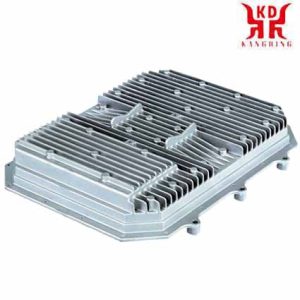 ラジエターシェルのダイカスト |
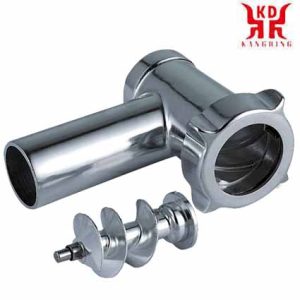 Die casting of meat grinder shell |
Shrinkage behavior of aluminum-silicon melts
If you pour liquid aluminum at about 700 ° C into a mold cavity in such a way that the mold is exactly filled, then the volume of the metal decreases to room temperature by a total of about 1.3% due to its contraction. Of this total, 0.05% is due to the liquid contraction, 0.75% to the solidification and 0.5% to the solid contraction.
This volume deficit of 1.3%, which is not much smaller with aluminum alloys than with pure metal, becomes noticeable in the solidifying cast part in the form of volume defects. In addition to normal shrinkage, these defects occur partly as sink marks, partly as macro-blowholes or as shrinkage pores.
The shrinkage cannot take place as unhindered in a die casting mold as it is in a sand casting mold, 例えば. In foundry technology, the term “収縮” means, in addition to a process, a measure, namely the percentage dimensional deviation of the cooled casting from the dimensions of the mold at operating temperature. Whether shrinkage can take place freely or with hindrance depends almost exclusively on the geometric shape of the cast part. It is therefore possible that the shrinkage rate of 0.5% that is generally used today can be used for many dimensions on one and the same cast part, while 0.4% could still be too much for other areas. The mold dimensions are to be determined taking into account a shrinkage drawing of the die-casting alloys concerned.
Shrinkage for die casting
| Die-cast alloy | Shrinkage in% |
| Aluminum alloys | 0,5–0,7 |
| Magnesium alloys | 0,5–0,8 |
| Zinc alloys | 0,4–0,6 |
Influence of the alloying elements in aluminum casting alloys
Silicon
structure
With 12.5% silicon, aluminum forms a eutectic1 that melts at 577 ° C. In the binary system there is no connection between aluminum and silicon. The solubility of silicon in solid aluminum is 1.65% in equilibrium at 577 ° C., drops to 0.22% at 300 ° C. and even further at lower temperatures. If an alloy has more silicon than the solubility corresponds, the structure contains not only aluminum mixed crystals but also silicon crystals. If the cooling rate is not particularly fast, the silicon solidifies in the eutectic mixture in the form of angular crystals, needles and plates. These forms of training are made possible by small admixtures of z. B. sodium, strontium, antimony or phosphorus influenced. Die casting causes similar effects due to the rapid solidification.
Eutectic1 is a mixture of alloying elements, which of all possible compositions has the lowest melting point. The eutectic point, e.g. 例えば .: an Al-Si alloy, is 12.5% そして 577 ° C.
Casting properties
The higher the Si content, the more advantageous it has on the flow and mold filling capacity. The flowability deteriorates as the Si content decreases.
Influence of silicon on the feeding behavior
With an increasing Si content, over 11%, the macro-void volume increases sharply. The incidence volume runs in the opposite direction to the macro void volume. With less than 9% Si, thick-walled parts tend to have suction cavities. The feeding options for macro-blowholes are limited in die casting (thick-walled cast parts lying from the gate cause some problems, since accumulations of material during the shot are filled last and then solidify). In hypoeutectic alloys, coarse grain becomes noticeable as a result of overheating from suction points.
A near-eutectic melt (around 11% Si) causes stronger macro-voids. Eutectic and near-eutectic Al-Si melts, which lead to a “granular” or “refined” structure, solidify with the formation of a peripheral shell (exogenous solidification), so that these melts are not susceptible to sucking holes.
鉄
A higher iron content has a positive effect on die casting (e.g., alloy EN AC-AlSi9Cu3 (Fe) 最大. 1.2%), as it reduces the tendency of the metal to stick to the mold surface. Within the tolerance limits, iron normally has no influence on the casting properties. Unintentional increase due to improper melting or working methods in the foundry can lead to embrittlement of the cast parts and undesired formation of cavities, hot cracks or sink marks. At low holding and pouring temperatures, gravity segregations often occur, which collect on the floor of the furnace. The segregation products consist of iron, manganese and silicon. The hardness of segregation products is 500–1000 Vickers.
銅
Copper additives reduce the solidification shrinkage. 結果として, copper-containing Al alloys permit pressure-tight castings more easily. Cu additives have a positive influence on strength and machinability. Copper reduces the corrosion resistance.
manganese
Manganese addition of a few tenths of a% reduces the negative influence of iron on elongation and impact resistance. しかし, if iron and manganese occur in a higher content, they can under unfavorable melting conditions, e.g. B. by low holding temperatures, lead to hard segregation.
マグネシウム
With the simultaneous presence of silicon, copper or zinc, magnesium leads to an improvement in machinability due to an increase in hardness. Magnesium has no negative influence on the corrosion behavior. Magnesium is also becoming more and more interesting in the automotive industry, especially because of its lower weight.
ニッケル
The most important advantage of the addition of nickel is the increase in heat resistance. Pistons and cylinder heads in particular are the main areas of application for nickel-containing aluminum alloys.
亜鉛
Different zinc content within the tolerance limits are generally without any influence. ダイカストでは, the Zn content together with magnesium is occasionally reduced in parts prone to hot cracks.
チタン
Titanium is added to Al alloys mainly as a grain refiner up to a maximum of 0.15%. In the case of sand and permanent mold casting alloys, it is a grain-refining alloy component.
鉛
In the solid state, lead is undissolved in the form of fine droplets. Within the tolerance limits (<0.1%), Pb does not noticeably influence the alloy properties.
錫
With a content of more than 0.02%, tin separates along the grain boundaries and has a very negative effect on hot cracking behavior if the normal tolerance is exceeded – especially in die casting.
Comparison of die casting and injection molding
The investment costs for casting machines and the high manufacturing costs for the mold are roughly comparable. In both processes, large numbers of pieces have to justify these high investment costs. After that, the raw material costs have priority.
Die-cast metal components have a significantly higher flexural strength (rigidity) than injection-molded ones; it can be up to 20 times higher. The workpieces produced in die casting can still be subjected to loads at higher temperatures (aluminum up to approx. 450 ° C). In the case of injection-molded materials, the strength and rigidity decrease sharply at higher temperatures (from 100 ° C); the only exceptions are expensive special plastics. Another advantage is that when the components (with the exception of zinc) are stressed, there is no creep, as is the case with many injection-molded workpieces. Die-cast parts have a much better structural stability, つまり. a mechanically processed surface remains a surface, whereby the surface of a plastic part deforms much more easily. Furthermore, some injection-molded plastics change shape under climatic conditions. Die-cast materials have electromagnetic shielding and are resistant to organic solutions. 加えて, recycling is possible without any loss of quality.
Injection molded components are cheaper if standard materials are used. 加えて, color can be used for injection molding. Another advantage is the lower weight compared to die-cast workpieces. The latter also have poorer corrosion properties. Furthermore, the production of die-cast metal components is more complex and “complicated” geometries are sometimes not possible.
 English
English العربية
العربية 中文(漢字)
中文(漢字) Čeština
Čeština Dansk
Dansk Nederlands
Nederlands Suomi
Suomi Français
Français Deutsch
Deutsch Italiano
Italiano 日本語
日本語 ಕನ್ನಡ
ಕನ್ನಡ 한국어
한국어 Português
Português Русский
Русский Slovenčina
Slovenčina Español
Español Svenska
Svenska Türkçe
Türkçe

